Details
- Publication date
- Source
- Green Deal Projects Support Office
Participatory tools are revolutionising the approach to data collection to feed into the work on climate adaptation. Many Horizon 2020 Green Deal Call-funded projects show that to be effective, the decision-making processes on climate change adaptation require data from a diverse range of data sources. The participatory tools developed by these innovative projects offer a number of benefits such as encouraging collaboration between different stakeholders, enabling the collection of local, on-the-ground, data, and bringing together society and policymakers.
In this article we look at the different tools and how they are used by the Green Deal Call-funded projects.
Exploring the different types of tools
Participatory tools take different forms and include for example web-based platforms, mobile apps, and toolkits that encourage end users to participate in the data collection and sharing process.
Web-based platforms are designed to be used on any device with an internet connection and a web browser without needing to install new software. As the application is based on a server, updates are made centrally, developments costs are minimised as there is no need to create separate applications for different platforms, and they can scale more easily to handle increased traffic and user loads. Users can interact with the application without being tied to a specific device. This makes these platforms highly accessible, and their cross-compatibility facilitates knowledge exchange by bringing together data from a diverse range of sources.
Mobile apps enable scientists to use local knowledge and to engage with and inform local communities of the issues and actions they can take to adapt to climate change. Compared to web-based platforms and tools, mobile apps provide extra flexibility by accessing information offline, even in remote areas. Additionally, push notifications deliver real-time updates and alerts facilitating the swift communication of urgent information and geolocation. The unique feature of the mobile apps lies in the personalisation of these push notifications and messages. Beyond this, the mobile apps offer a range of advantages such as seamless integration with diverse sensors for better data collection and they play a crucial role in encouraging behavioural- and lifestyle-change.
Toolkits typically consist of a set of tools such as web-based platforms and mobile apps which, when combined, help their users make more effective decision-making for climate change adaption. These toolkits can offer a larger, more comprehensive set of resources, frameworks, and/or products for users seeking a holistic understanding of climate-related issues and solutions.
Other online tools and services aimed at fostering participation and encouraging data, exchange, as well as identifying solutions for its end users.
Project examples
Projects under the climate change adaptation working group of the Green Deal projects Support Office make use of participatory tools to provide various climate services to their end users. Below, we highlight a tool for each project which has been developed to combat climate change and encourage climate adaptation.
FIRELOGUE
FIRELOGUE has created an online information platform, ‘Fire up the Dialogue’ which brings together expertise from across Europe related to wildfire risk management . The FIRELOGUE platform collects and consolidates knowledge, findings, and solutions from other EU-funded projects – including FIRE-RES, SILVANUS, TREEADS – and FirEUrisk, as well as other international projects in the field of wildfire risk management. By providing an area for sharing information, innovative solutions, and products, the platform is designed to connect services and stakeholders. The platform also provides links to other wildfire risk management platforms, alongside information on events and publications relevant to the wildfire risk management community.
The three wildfire risk management projects - FIRE-RES, SILVANUS, and TREEADS - each aim to prevent and extinguish wildfires via three key phases (see Figure 1). These phases are: 1. promoting engagement and interconnection of the public and forestry management representatives, 2. enabling early detection of wildfires via reporting and warning the public through alert notifications and visual information, and 3. promoting a knowledge base and disseminating other relevant information. To do so, each project has developed participatory tools and products which are fed into the FIRELOGUE platform.

FIRE-RES
The Geo Catch App from FIRE-RES uses mobile-based surveying approaches for wildfire fuel types and landscapes. This exclusive survey approach enables users to collect on-the-ground data that represents the real-world variation of fuel types and landscapes.
With its user-friendly interface (see Figure 2) and comprehensive data collection approach, FIRE-RES’s Geo Catch mobile App is poised to make a significant contribution to improving forest fuel maps in Europe. By empowering stakeholders and everyday citizens, the app holds the potential to reduce fire ignitions caused by human activities and alleviate the burden on fire management agencies during each fire season.
To date, the project has hosted training sessions to enable the fire service, the forest service, researchers, and citizens to familiarise themselves with the app. Bulgaria has indicated the highest interest in the training sessions – dem onstrated by uploading the highest number of photos to the system. This training will be followed by other living labs hosted in Galicia, Sardinia, and Greece.
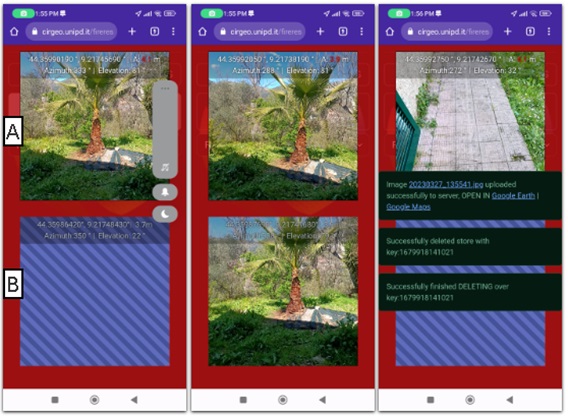
SILVANUS
Taking a different approach to the previous tools, SILVANUS has developed an Augmented Reality (AR)/Virtual Reality (VR) toolkit for combatting and responding to wildfires. The toolkit provides firefighters and first responders with a unique opportunity to experience training exercises via virtual modelling environments and wildfire simulations but based on real data from operational scenarios (see Figure 3). By providing real-time information on the status and the environment of a developing wildfire event, this engaging toolkit improves decision-making for major incidents and critical situations to help firefighters avoid dangerous situations by gaining experience from real scenarios. A key benefit of the toolkit lies in encouraging user participation in training programmes and allowing users to tailor scenarios based on their training needs.
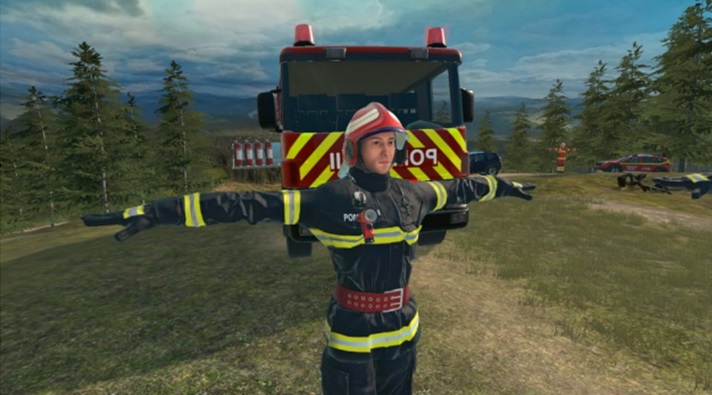
TREEADS
Venturing into advanced technology, TREEADS has developed and integrated a variety of innovative products and tools (Figure 4) to address the major challenges that wildfires pose. These include coordinated pilotless aircraft and satellite systems, drone seeding technology, the use of satellite data, an advanced analytical and modelling framework for tackling forest fires, new fire resilient materials, insurance models, augmented reality tools for fire responders – all packaged up into a Holistic Wildfire Management Platform. This platform is designed to integrate and share expert knowledge on forested social and ecological systems, forest economics and policy, and existing EU initiatives and services, thus fostering a multi-stakeholder approach to wildfire risk management.
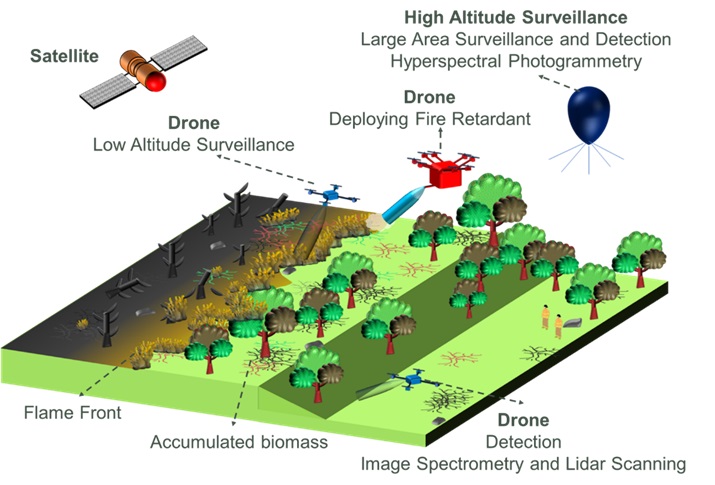
LOCALISED
Moving away from wildfire risk management and onto wider climate change support tools, most of the European information platforms that exist to support the transition to net-zero are limited to providing information targeted at the national level. In contrast, the LOCALISED project is developing tailored regional data on energy and climate impacts. These data will be integrated into information tools for regional governments, communities, and businesses, to support the decarbonisation of their regions and adaptation to climate change. These actions contribute to the European Green Deal target of a fair and equitable transition to 55% net greenhouse gas reduction by 2030 (compared to 1990) and ensuring there are opportunities for everyone and leaving no one behind.
One of LOCALISED’s tools will be the Decarbonisation and Adaptation Profiler, a web-based information and decision support tool which aims to encourage municipalities or regions and their citizens to conduct mitigation and adaptation planning. The LOCALISED Decarbonisation and Adaptation Profiler is designed to be a mobile-friendly web application and will be launched at the beginning of 2025, with a demo version in spring 2024. In addition, the Net-Zero Business Consultant tool will provide local and regional businesses and business support organisations with insights and practical guidelines into effective mitigation and adaptation options and showcasing the role of emerging technologies.
The co-design process with a focus group of potential end-users started in November 2023. If you are interested in taking part and want to be the first to see different decarbonisation pathways for your region, contact the LOCALISED project.
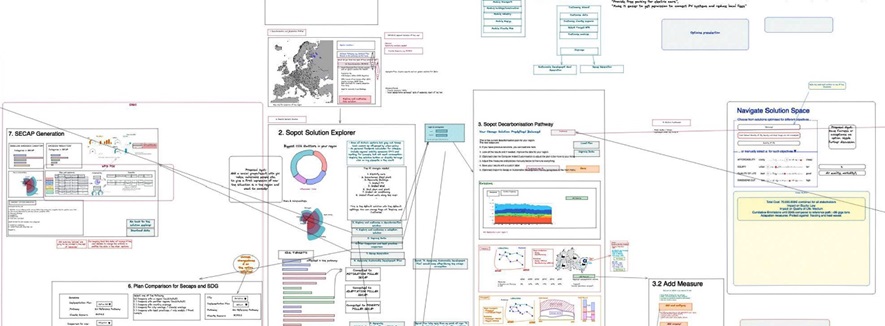
REACHOUT
Staying on the theme of local adaptation, the Triple-A-toolkit from REACHOUT aims to support cities to Analyse hazard, exposure, and vulnerability to climate change, formulate Ambitions for Climate Resilient Urban Development, and identify, evaluate, and select adaption Actions for implementations (see Figure 6). The triple-A approach builds on existing tools and climate information, land use data, and socio-economic indicators, and has been shaped through active engagement from citizens and the private sector. It is designed to be used by city hubs which serve as living labs that apply the toolkit and provide the platforms for co-creation.
To date, REACHOUT has delivered three of four modules from their learning programme aimed at supporting the city hubs’ implementation of the tools, monitoring capacities, and adaptation, by addressing the main barriers for uptake and learning from its achievements in providing climate services.
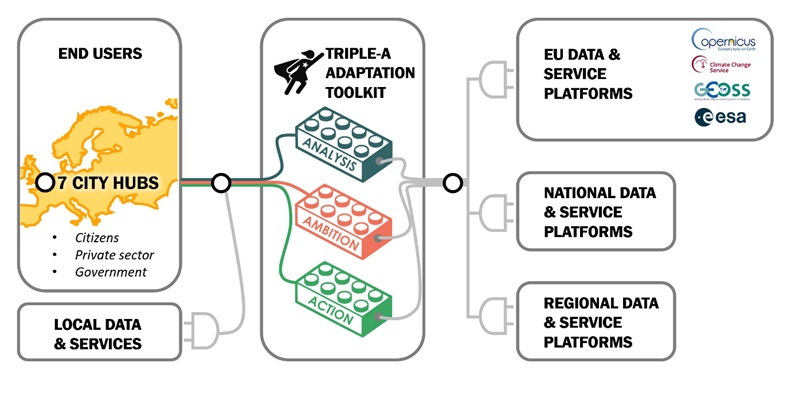
CityCLIM
Another project that supports the climate adaptation of urban areas is CityCLIM, which aims to reduce urban heat stress by delivering a range of city climate services. The project is currently developing the web-based Climate Portal Services (CPS), which will provide current and historic weather conditions to citizens (see Figure 7), focusing on disseminating local and regional knowledge. The CPS will also encourage the involvement of citizens and stakeholders (as citizen scientists) in the process of decision-making via the creation of easy-to-use web tools with interactive user interfaces.
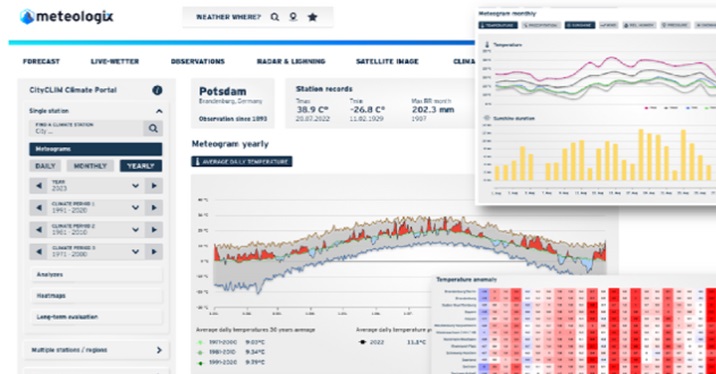
REGILIENCE
While many adaptation actions are being implemented to address the pressing challenges posed by climate change, it is important to also address the potential risks associated with these measures. REGILIENCE has developed an online Self-Assessment Tool explicitly focused on spotting early potential risk factors for maladaptation - actions intended to reduce the impacts of climate change but which actually create more risk and vulnerability.
With this tool, users are guided through a checklist of 17 questions, each one focusing on one risk factor for maladaptation (see Figure 5). By responding to questions in selecting yes/no/partially for each of the risk factors, the tool highlights the maladaptive potential of the planned action, enabling regional planners to assess risks and make informed decisions. Its objective is to help users (regional authorities, consultants for the administrations, civil society organisations (CSOs) dealing with climate adaptation) to avoid or reduce maladaptation risks in the planning phase of adaptation actions.
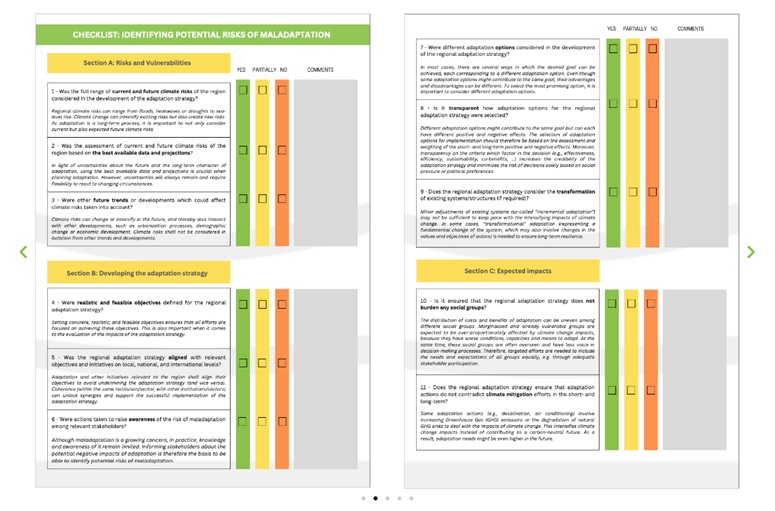
TransformAr
To round off the list, we finish with TransformAr, a project which aims to create products and services to introduce large-scale and disruptive adaptive Transformational Adaptation (TA) processes in vulnerable regions and communities across Europe. It has developed a Playbook for Transformational Adaptation for organisations with big and bold ambitions drive transformational change in response to the climate.
The Playbook provides an overview of the essential tool’s users will need for designing adaptation pathways in their communities, guides readers in how to discover opportunities with local stakeholders and offers methods to evaluate progress. The Playbook is being developed into a web-based tool, and is currently available in PDF format, including printable materials for stakeholders to organise workshops (see Figure 9).
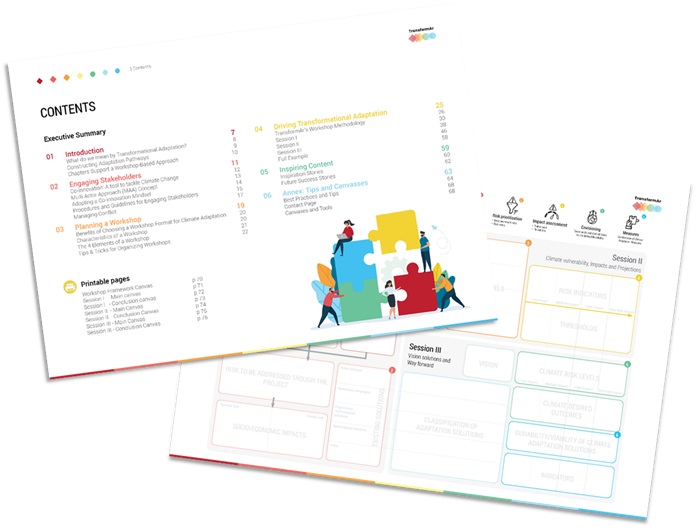
Other project developments
In addition to the examples showcased above, other projects are in the process of developing participatory tools to help combat climate change. These are currently in development and will be showcased in more detail in a future article.
ARSINOE: Offering advanced Environmental Intelligence services and tools, through an interactive platform allowing multiple stakeholders to collaborate.
IMPETUS: Gathering knowledge about scientific, technical, social, and policy developments in local ‘Resilience Knowledge Booster’ (RKB) hubs.
RethinkAction: Developing a platform that will encourage the participation of citizens, stakeholders, and decision-makers, and bring them together to explore land use approaches and behavioural change to address the climate emergency.
Key take aways
There are a variety of participatory tools being developed by the Green Deal Call-funded projects including online platforms consolidating expertise, mobile apps for on-the-ground data collection, augmented reality/virtual reality toolkits for firefighting training, and self-assessment tools to identify potential risks of maladaptation. The value of these participatory tools lies in their ability to collect and consolidate a range of climate-related knowledge, solutions, products, tools, and services between stakeholders and sectors necessary for addressing the challenges posed by climate change. The key benefits of participatory tools such as web-based platforms, mobile apps, and adaptation toolkits include enhancing user engagement and improvements to data collection, encouraging stakeholder and citizen involvement (particularly early-on in decision-making processes), and offering a holistic understanding of climate-related issues and solutions.
In the face of the immense challenges posed by climate change, these tools guide a path toward a more resilient and sustainable future. By harnessing the power of collaboration, local knowledge, and cutting-edge technology, we can not only adapt to the impacts of climate change but also pave the way for transformative and inclusive solutions.

